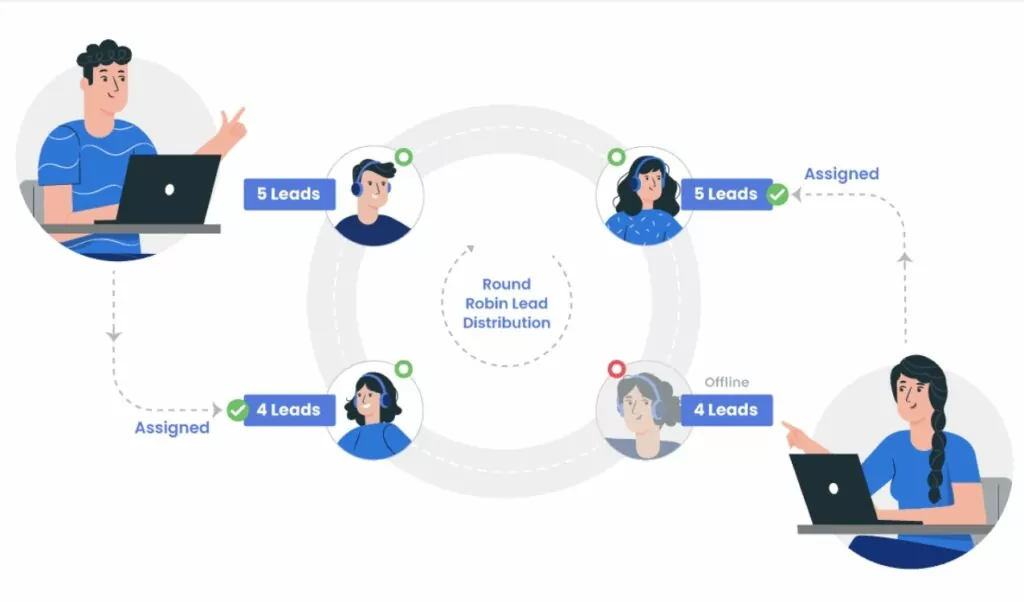Lead distribution is an essential bridge from collecting quality leads to converting leads into customers. Without a good lead distribution strategy in place, you will lose valuable leads or improperly match potential customers with ill-equipped sales representatives.
Today we will help you prevent that from happening by going over lead distribution from A to Z so that you can identify the best practices for your franchise.
Key Takeaways:
- Lead distribution ensures consumers are promptly matched with the best reps.
- You can either distribute your leads manually through a pull-based system or automatically through a push-based strategy.
- The best lead distribution methods combine several strategies to ensure your leads are distributed equally, compatibly, and competitively.
What Is Lead Distribution?
Lead distribution, or lead routing, is the fourth step in the sales funnel. It occurs after your sales and marketing teams qualify the leads. Then they send those leads to representatives for nurturing and ultimately for conversion. This process is done manually, automatically, or with a combination of both.
Distribution strategies can be as simple as handing leads off to the next available representative, or as complex as matching each consumer with the most compatible and experienced reps. For example, as a franchise, you may want to match your leads with reps familiar with the consumer’s nearest franchise location.+
The Lifecycle of a Lead
Here is a quick overview of the lifecycle of a lead from generation to conversion that provides more context to the lead distribution stage.
- Generation is the sales and marketing strategies you implement to attract potential customers to your brand.
- Capture is how you receive the contact information from a lead, such as from contact forms or account sign-ups.
- Qualification is sorting the leads by their potential for turning into customers based on their demographics, interest level, and previous touchpoints.
- Distribution is handing qualified leads to sales associates for nurturing through a lead allocation process.
- Conversion is turning a lead into a customer.
Source: Fit Small Business
In this process, speed is essential as 50% of customers will choose the business that responds first. That is why many companies rely on automated systems to help them move leads through the sales funnel faster.
Benefits of Lead Distribution in Franchises
Lead distribution in franchises is essential for ensuring each lead connects with a sales representative familiar with the location nearest to the lead. A Knowledgeable rep will help the consumer have a better customer experience because they will receive relevant and relatable answers to their questions.
Lead distribution is also an efficient strategy because it keeps every marketer and sales rep informed about their responsibilities. It also improves lead tracking, allowing your analytics team to map the consumer’s journey.
Pull-Based Lead Distribution
Pull-based lead distribution is also known as manual lead distribution. Manual distribution is better suited for smaller businesses with fewer leads than franchises. However, you can still implement these processes in your franchise if you pair them with an automated process, which we will explore later.
Cherry-Picking
In cherry-picking, each sales representative chooses the consumers from a pool of leads. Often reps will pick leads based on the lead’s quality. With this method, reps will work at their own pace with little incentive to move quickly. If their speed doesn’t match the number of incoming leads, you risk losing valuable potential clients.
Blind Pull
With the blind pull method, your reps work similarly to cherry-picking. The main difference is that your agents can’t see information about the client when pulling the lead. As a result, this method helps provide more equal opportunities for each rep to work with high-quality leads.
Shark Tank
The shark tank method is the most competitive manual option as reps can grab each lead as soon as it is available. This method can result in a few agents taking on most of the leads while the others don’t have any.
Push-Based Lead Distribution
Push-based lead distribution, or automatic lead distribution, is when you use a software platform to pass out leads to available reps. These methods encourage workers to move faster to keep up with their assignments.
Here are a few of the most common push-based methods.
Round-Robin
The round-robin method is the simplest form of automatic lead distribution. In this strategy, the software will send leads to each rep in an ordered fashion, such as going down an alphabetical list. Once every representative receives a lead, the software begins at the top again.
While this process is efficient, you will also lose valuable time if all your reps won’t finish simultaneously. In addition, the platform will also not take other demographic or expertise information into account in the process.
Source: Limecall
Customized Rules
To customize the round-robin strategy, many businesses will add specific rules for distribution to help match leads to the best-equipped rep. These might include routing leads according to:
- A lead’s geographic location
- A rep’s availability
- A lead’s demographics
- A rep’s expertise
Over 80% of consumers would like a personalized experience. Matching them with the most relevant representative rather than the first rep will help provide that experience, increasing your conversions.
Performance-Based
Performance-based lead routing is a method of incentivizing your employees to work harder and faster because the quality of their leads will depend on their performance. For example, workers who have higher conversions might receive more high-quality leads. You may also prioritize workers who have been employed the longest.
One con of this method is that the reps who aren’t high performers will often find themselves stuck at the bottom of the list. Unfortunately, since they will not receive many quality leads, they will not have much opportunity to rise up the list.
Combined Methods
The best method is a hybrid of several of the above. If your workplace competition is not regulated, your employees will soon feel exhausted from trying to keep up. However, allowing controlled competition or cooperative competition is a healthy way to encourage better performance.
For example, you might consider dividing your sales reps into groups based on their demographics, experience, or performance. Then, you can assign leads based on the round-robin method. Once the leads come in, you might allow the reps in the smaller groups to use the shark tank method, which would motivate them to perform more efficiently. In this way, you balance equal opportunity and performance-based strategies with a healthy level of competition.
Automate Your Lead Distribution
Are you ready to stop losing high-value leads due to delayed transfers or miscommunication?
Then you need to automate your lead distribution. You can set up rules that will assign each customer with the rep that best matches their needs through lead distribution software.
If you are interested in learning more, schedule a demo to see how our software can help you increase your conversions by tracking and automatically distributing your leads.
Feature Image: istockphoto







